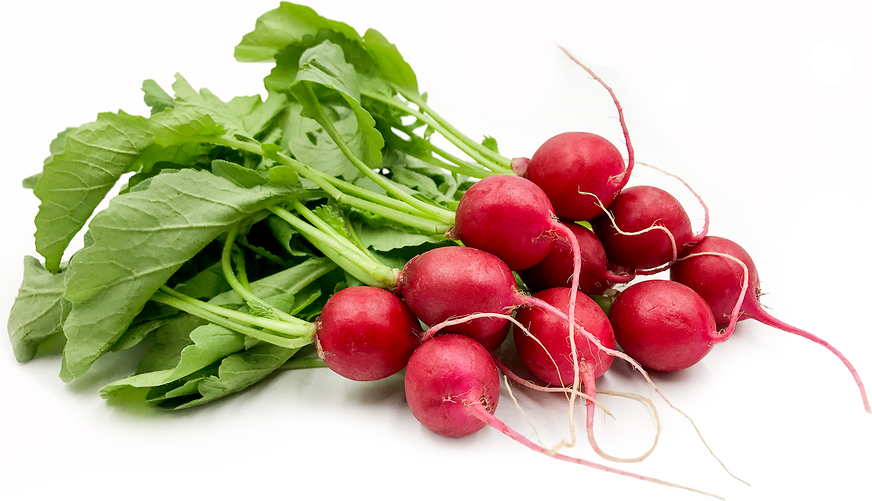


Japanese Red Cherry Radish
Estimated Inventory, bag : 0
Description/Taste
Japanese Red Cherry radishes are a small varietal, averaging 2 to 4 centimeters in diameter, and have a round to oval shape with a single, elongated taproot. The radish’s skin is smooth, taut, and thin, ranging in color from bright red to red-pink. Underneath the surface, the flesh is dense, aqueous, and white with a crisp and crunchy, snap-like consistency. Japanese Red Cherry radishes have a semi-sweet, peppery, and sharp flavor. Once cooked, the flesh softens to a texture similar to a potato and develops a neutral, nutty, and peppery flavor. In addition to the roots, Japanese Red Cherry radish leaves are also edible and have a pungent, green, and grassy taste. The soft and crisp leaves are attached to the roots through fibrous green stems and have a ruffled, textured surface with prominent veining and serrated edges.
Seasons/Availability
Japanese Red Cherry radishes are available in the early spring to the late fall.
Current Facts
Japanese Red Cherry radishes, botanically classified as Raphanus sativus, are a small, versatile cultivar belonging to the Brassicaceae family. The red, round radishes were introduced to Japan from Europe sometime in the late 19th and early 20th centuries and are a popular table variety, commonly grown in home gardens and balcony containers. Japanese Red Cherry radishes are also known as Akamaru Daikon, meaning “Red Circle radish,” and Hatsuka Daikon, meaning “Twenty-day radish,” in Japanese. The radishes received their “twenty-day” moniker from their ability to be harvested within 20 to 30 days after sowing, and daikon is a term used more broadly as a generic label for radish. There are several varieties of Japanese Red Cherry radishes, and these globular roots are used throughout Japan as an everyday ingredient in fresh and cooked culinary preparations.
Nutritional Value
Japanese Red Cherry radishes are a good source of fiber to regulate the digestive tract and vitamin C to strengthen the immune system while reducing inflammation. The roots also provide potassium to balance fluid levels within the body, calcium to protect bones and teeth, vitamin E to guard the cells against the damage caused by free radicals, and contain other nutrients, including magnesium, B vitamins, folate, vitamin K, copper, and zinc.
Applications
Japanese Red Cherry radishes have a peppery flavor and crisp nature well suited for fresh and cooked preparations. The radishes can be sliced and displayed on charcuterie plates, chopped and tossed into salads, sliced thin and served with dips, or shredded into slaws. Japanese Red cherry radishes can also be combined into fresh spring rolls, served with sushi or sashimi, layered into sandwiches, or pickled as a tangy, crunchy element. In addition to raw preparations, Japanese Red Cherry radishes can be cooked into soups and stews, roasted whole, sometimes coated in brown butter and lemon sauce, stir-fried, or braised and served with meats. In recipes, the small radishes can be used interchangeably with other globe radish varieties. The leaves are also edible and can be mixed into soups, sauteed as a savory green, or braised as a bed of greens. Japanese Red Cherry radishes pair well with meats such as beef, pork, and poultry, tofu, eggs, herbs including thyme, dill, parsley, cilantro, and chives, dark leafy greens, and aromatics such as garlic, shallots, and onions. Whole, unwashed Japanese Red Cherry radishes will keep 1 to 3 weeks when stored in a plastic bag in the refrigerator.
Ethnic/Cultural Info
In Japan, Red Cherry radishes are sometimes used as a decorative garnish, meticulously sliced, pickled, and fanned to resemble multi-petaled chrysanthemum flowers. The original recipe was traditionally used with turnips, known as kikka kabu, and was a typical dish served for Osechi Ryori, or food for New Year’s Day. Osechi Ryori is the most important meal of the year in Japan, and each dish consumed on the day symbolizes a wish for the upcoming year. Kikka kabu is often served between small plates as a palate cleanser, sometimes referred to as hasiyasume. In the modern-day, the tangy, semi-sweet, and fermented dish is also made with Red Cherry radishes. The radishes are favored for their red and white coloring, said to symbolize happiness, also matching the colors of Japan’s flag, and are sliced to resemble chrysanthemum flowers, a symbol of the Japanese Royal Family. Chrysanthemums were introduced to Japan during the Nara period, sometime between 710 to 793 CE, and the emperor loved the flower so much that he selected it to be on the emperor’s crest and the imperial seal of Japan. Chrysanthemum flowers represent longevity, and consuming Red Cherry radishes pickled into the flower-like shape is viewed as a wish for happiness and long life in the year to come.
Geography/History
Japanese Red Cherry radishes are descendants of European radish varieties that were developed in the Mediterranean in the 16th century. The small and round radishes were later introduced from Europe to Japan during the Meiji Period, sometime between 1868 and 1912. After their introduction, Japanese Red Cherry radishes flourished as a home garden cultivar as their small size was compatible with container growing and being sown in small gardens plots. They were also cultivated on a small scale for commercial markets. Today Japanese Red Cherry radishes are primarily produced in the Aichi Prefecture and are planted in greenhouses to create an optimum growth environment. The radishes are also cultivated in Fukuoka and Hokkaido Prefectures and are sold through local markets, grocers, and distributors.
Recipe Ideas
Recipes that include Japanese Red Cherry Radish. One
| The Splendid Table |
|
Fast Japanese Pickles |




